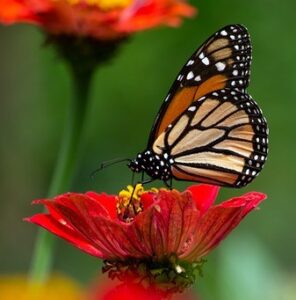We have an amazing amount of insect biodiversity in our gardens and landscapes including hundreds of species of bees and wasps.
Why do Insects Sting

Both bees and wasps can sting. A stinger is a modified ovipositor (the egg-laying mechanism in insects), so only females can sting. The purpose of a stinger is defense, and in some species, predation on other insects. Generally, insects will only sting if they are provoked or if they feel their colony/nest is threatened. Wasps can sting more than once, while honey bees can only sting once. Western yellow-jackets and European paper wasps tend to give all stinging insects a bad reputation because they cause the highest number of stings. Western yellow-jackets alone are responsible for 90% of all insect stings! If you observe insects in your own landscape, you might notice some other species of bees and wasps pollinating and preying on pest insects.
 Bald-faced Hornets and Aerial Yellow-jackets
Bald-faced Hornets and Aerial Yellow-jackets
Bald-faced hornets and aerial yellow-jackets are two other species of social wasp that people may encounter. They build funnel-shaped paper nests usually high in the trees. While their nests can be a considerable size, these wasps are usually far enough from human activity that most people don’t know about them until the leaves fall off the trees in autumn. Both species will only sting if their nest is threatened. Since the colonies are only active for one season, nests can remain in the tree and will disintegrate over time. Nest removal may be required if the nest is too close to human activity (e.g. if children are climbing the tree).
Solitary Bees and Wasps

Hundreds of species of solitary bees and wasps visit and nest in our gardens every day. These insects go about their business of pollinating flowers and preying on pest insects, and we rarely notice them. It’s extremely difficult to get stung by a solitary bee or wasp since they don’t have a colony to protect. They usually need to be handled or pressed up against your skin for a sting to occur. Males cannot sting. These beneficial insects can be enjoyed by observing them on flowers or at insect hotels without the risk of getting stung.
Attracting Pollinators to your Garden
Adding pollinator-friendly flowers and habitat to your landscape will not increase the risk of stings. This is because most stings are caused by the western yellow-jackets, and they don’t visit flowers. Pollinator-friendly plants can be a great way to attract beneficial insects. Which in turn will attract birds and other wildlife that rely on insects as part of their diet. Hummingbirds rely on insects for as much as 70% of their diet! Many pollinator-friendly plants have low water requirements, an added bonus. Learn more about creating pollinator habitat here.
To learn more about bees visiting your gardens, visit NativeBeeWatch.org. For more information about yard and gardening topics, click here to sign up for The Garden Buzz newsletter from CSU Extension Master Gardeners in Arapahoe County.

